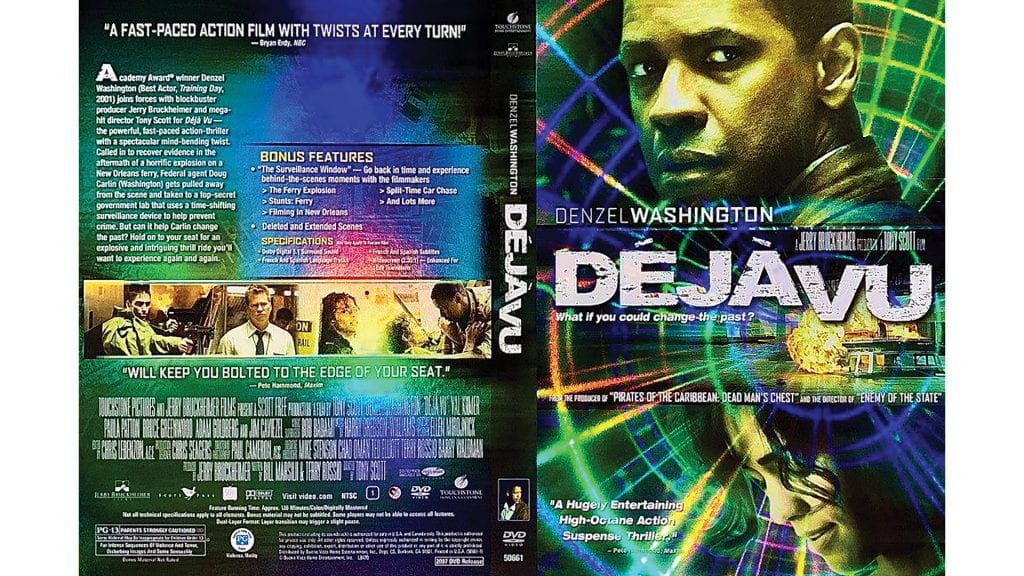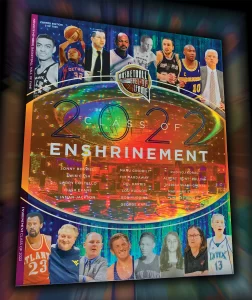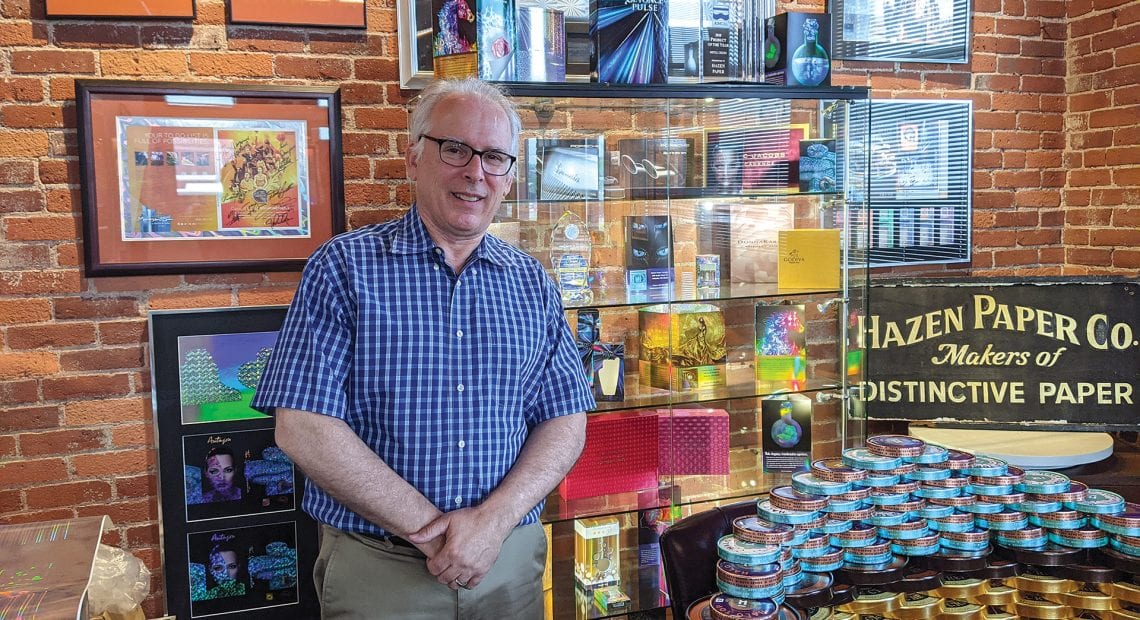Moving Pictures

John Hazen stands beside displays of just a fraction of the products created at his company using holographic technology.
Hazen Paper, a third-generation family business that’s approaching a century in operation in the Holyoke mill district, has never stood still, expanding its operation over the years into facets like foil laminating, specialty coating, and rotary embossing. But its emergence over the past 15 years as an internationally celebrated producer of holographic printed products may be its most profound shift. Its entry into this niche was a calculated risk, the company’s co-owner said, but one that gradually paid off in a striking way.
John Hazen figured there was some risk in purchasing his first holographic printer back in 2005. But, as the third-generation co-owner of Hazen Paper Co. in Holyoke, he also saw the potential.
“I always say I was like Jack and the beanstalk,” he told BusinessWest. “Dad sent me out with a bag of beans — ‘grow the business, son!’ — and I bought this crazy thing called a holoprinter.”
But he was determined to build Hazen’s footprint in the world of holographic printing, and plenty of other technology at the company sprung from that first investment.
The results? Well, the numerous awards that pour in every year testify to the company’s success. Like a 2021 Product Excellence Award from the Assoc. of International Metallizers, Coaters and Laminators (AIMCAL), for a holographic consumer package.
“To magnify visual effect on a very small carton,” the press release for the award reads, “Hazen micro-embossed specially coated polyester film with ‘Mercury,’ a unique overall holographic pattern, then metallized the film and laminated it to a solid bleached sulfate board before registered sheeting. The film lamination delivers mirror-like brightness and a liquid-flash effect of full-spectrum color, as well as durable performance for clean scoring and folding.”
“I always say I was like Jack and the beanstalk. Dad sent me out with a bag of beans — ‘grow the business, son!’ — and I bought this crazy thing called a holoprinter.”
Most of those words won’t register with the average consumer. But the effect of the packaging certainly does. “This package really stood out,” one judge said. “The embossed areas are like a hallmark and impart a feeling of luxury.”
It’s the latest in a string of AIMCAL awards for Hazen, which also earned the association’s Product of the Year honors in 2018, 2019, and 2020. The latest was for a transfer-metallized carton, featuring custom holography, created for Nordic Premium Beverages’ Arctic Blue Gin, a project made with Hazen Envirofoil, which uses less than 1% of the aluminum of traditional foil laminate — one way the company continues to stress sustainability, which is being increasingly demanded by clients.

The carton for Arctic Blue Gin, made using Hazen Envirofoil, earned Product of the Year honors in 2020 from the Assoc. of International Metallizers, Coaters and Laminators (AIMCAL).
In fact, it’s understanding customer needs that led Hazen to step into the world of holography with two emphatic feet in the first place. “In many ways, it’s requests from the customers, information coming in from the market — trying to identify opportunity.”
For background, he explained that the holographic industry saw significant consolidation between 2000 and 2004. In the late ’90s, holographic manufacturers were mostly small mom-and-pop shops, but that changed when larger players started buying them out. One of the catalysts was … well, toothpaste.
“When Colgate came out with a line of holographic packaging on their toothpaste … in the world of holography, the world of consumer packaging, that was a major event,” Hazen said. “They gained market share against Crest, and that’s what it’s all about. If they can pick up 1%, it’s massive. Once Colgate truly validated the use of holography, things got pretty exciting.”
Another growth area was DVD packaging — in fact, Hazen would go on to create holographic images for the DVD boxes for numerous major films, including for the likes of Pixar and Marvel. But its entry into that niche came in 2004, when it created the DVD packaging for the TV show Quantum Leap, which involved a custom hologram.
By that time, however, some of the small holographers Hazen used in the ’90s had been bought up, so it turned to one of the big conglomerates, Illinois Tool Works, or ITW, which had bought up several of the small, boutique holographers.
“We had to work with ITW, but we didn’t feel like they were using their power very well,” Hazen recalled. “We got the job done, and it won an award — and the feedback we were getting from studios and box makers was that this could be big.”
So, seeing the expanding opportunities in front of him, Hazen started creating an in-house holographic division.
Around 2005, “one of the companies that got acquired got busted into pieces, and we were able to start reassembling the pieces of the broken puzzle,” he recalled. “We set up our holographic lab, bought the holoprinter technology, hired some castoffs from the consolidation era, and set up a holographic lab in the basement. Since then, we’ve been able to expand.”
Shining Examples
Holography isn’t particularly new in the corporate world, Hazen said, noting its use on the dove image on Visa cards.
“That’s a hologram. They’ve had that on the Visa card for 40 years. A lot of times, holography is used as a branding feature, but also as a security feature. It authenticates, makes it hard to counterfeit. It’s done with money as well. That’s security holography, and it tends to be small.
“The holography we do for decorative packaging and some branding is larger format,” he went on. “We’re producing holographic plates as big as 60 inches by 60 inches. It’s not security holography and tends to be lower-resolution. But it is very unique; it’s hard, if not impossible, to replicate. And from a graphic point of view, it gives the graphic artist a mechanism for providing backlighting, for creating movement, for creating a 3D kind of effect.”
Hazen also uses a digital process — several different ones, actually, as opposed to Visa. “The Visa dove is analog — they created the model of a dove, set up lasers around a room, and got light to refract and bounce back.”
“We got the job done, and it won an award — and the feedback we were getting from studios and box makers was that this could be big.”
These days, Hazen Paper’s holography can be seen in hundreds of applications worldwide, from product packaging to the program covers for annual events like the Basketball Hall of Fame enshrinement (since 2013) and the Super Bowl (since 2004, although not in 2021, since there were questions early on about the game’s scheduling during COVID-19, and the design process has to start many months in advance).
Hazen showed off a copy of the 2020 hoops-hall enshrinement program, the class that includes the likes of Kobe Bryant, Tim Duncan, and Kevin Garnett. It showcases 3D imagery of the Hall of Fame’s iconic dome and spire and its panoramic interior, juxtaposed with a collage of the year’s inductees in action. The back cover is a holographic treatment of Mohegan Sun in Connecticut, where the enshrinement ceremony was held. Again, it used the sustainable Envirofoil process.


Top: the holographic Kat Von D Metal Crush limited-edition powder highlighter carton won AIMCAL’s Product of the Year honors in 2018. Above: one of the many DVD packages Hazen has created over the past two decades.
Hazen has also added to its trophy shelf multiple times in the past year, including a Next Century Award from Associated Industries of Massachusetts, which recognizes employers, individuals, and community organizers that have made unique contributions to the economy and residents of Massachusetts. The company employs 200 people and participates in an internship program with Western New England University that helps engineering students gain experience.
“We create opportunities for young people to learn about the industry in general and our operation in particular — and expand our future talent pool,” Hazen said when the award was announced.
And back in December, the International Hologram Manufacturers Assoc. (IHMA) named Hazen Paper’s 2020 holographic calendar Best Applied Decorative/Packaging Product at its Excellence in Holography Awards.
Featuring a fire-breathing dragon with three-dimensional scales, the oversized calendar utilized an array of innovative holographic techniques to create a decorative design the IHMA called “outstanding.” These holographic designs included gray-motion for the sky background, color-motion for the dragon, and two-channel color-motion lenses and fire-motion lenses to animate the flames.
And the company continues to innovate. For example, it announced back in August it had created an innovative, two-sided promotion to demonstrate cutting-edge holographic technologies. The Hazen team designed the artwork on both sides to showcase specific visual effects with nano-holography that delivers an even more dramatic three-dimensional effect.
Perhaps the most unusual aspect of the promotion is that it is two-sided custom holography, transfer-metallized on both sides. “It hasn’t been done before,” Hazen said last summer. “The ability to transfer-metallize a lightweight stock on two sides with custom holography opens up the potential for use in many applications where consumer impact is key. It’s very exciting.”
Changing Times
Clearly, Hazen Paper has come a long way from its origins in 1925, when Hazen’s grandfather, also named John, launched the enterprise as a decorative paper converter and embosser. His younger brother, Ted, joined Hazen in 1928 to help manage the growing company, which grew rapidly in the 1930s and expanded into printing and foil laminating by the 1940s.
Ted’s son, Bob, joined the company in 1957, and John’s son, Tom, signed on in 1960, and the second generation expanded the company numerous times over the next three decades, as Hazen Paper became known worldwide for specializing in foil and film lamination, gravure printing, specialty coating, and rotary embossing. Hazen products became widely used in luxury packaging, lottery and other security tickets, tags and labels, cards and cover stocks, as well as photo and fine-art mounting.
The third-generation owners, John and Robert Hazen, joined the company at the start of the 1990s, and have continued to grow the enterprise and expand its capabilities, with a special emphasis on coating, metallizing, and — of course — holographic technology.
In 2005, Hazen Paper set up its holographic origination lab and design studio in Holyoke, and has since developed thousands of unique holographic designs and holds several patents on the processes it has developed. Shortly after, the company launched a holographic embossing and metallizing operation a mile away on Main Street.
“They always say it’s dangerous to go outside your traditional business model, outside your wheelhouse,” John Hazen said of those early days in this new niche, and particularly that plant. “We came in way over budget, at least six months behind, but that plant came to life right at the end of 2008.”
That’s right — at the beginning of a crippling recession.
“When you think about what was going on in the world, the first half of 2009 was really a scary time,” he said. “Fortunately, the business came back in the summer of 2009, and everything started to fall into place.
“Everyone’s system for making holography is different — they’re similar, but they’re different — but the one thing we knew was our system worked,” he went on. “But we went through some rough years from 2010 to 2016. We definitely overextended ourselves to get into the holographic business, and part of that overextension was the impact of the 2009 recession.”
In 2006, Hazen set up its first satellite plant in Indiana, a lamination and sheeting operation that ultimately operated 24/7, with more than 50 full-time employees. In 2016, however, it sold the plant as a strategic move away from commodity-type foil laminations to increase focus on growth opportunities in holography and specialty paper products in Holyoke.
Broadly speaking, packaging remains the broadest category of holographic work nationally, with designs seen on everything from boxes of golf balls and toothpaste to liquor packages. But the sky is the limit, Hazen said, and new uses emerge all the time — justifying that initial investment more than 15 years ago.
“It really was a startup, a technology startup in an older company. And ultimately, we really reinvented Hazen Paper,” he told BusinessWest. “The holographic technology ended up feeding the old business. So it’s like we installed a new heart in an old body.”
Not a bad return on that bag of beans.
Joseph Bednar can be reached at [email protected]



 According to Hazen President John Hazen, “though some of the visual elements — typography, portraits, logo — return, our holographic team flexes its technical prowess, amplifying the special effects each time to ensure the cover is more exciting than ever.”
According to Hazen President John Hazen, “though some of the visual elements — typography, portraits, logo — return, our holographic team flexes its technical prowess, amplifying the special effects each time to ensure the cover is more exciting than ever.”






